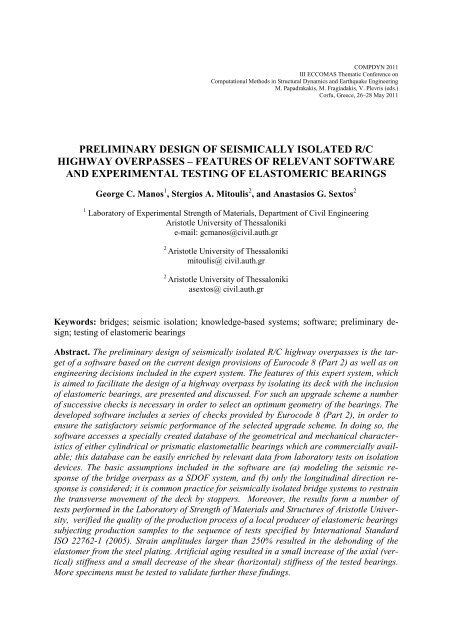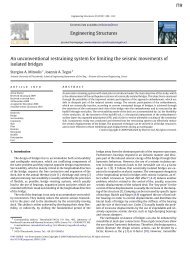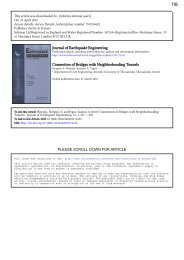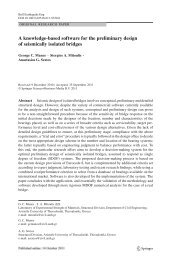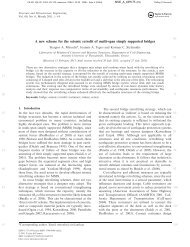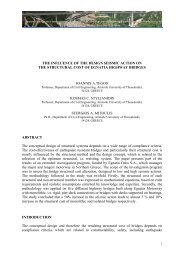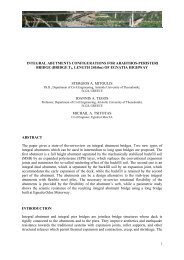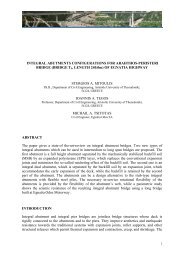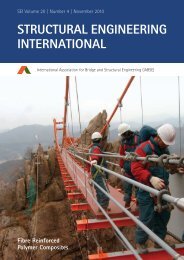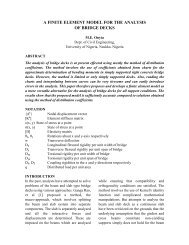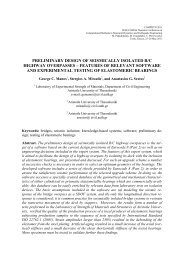18 Preliminary design of seismically isolated RC highway overpasses
Create successful ePaper yourself
Turn your PDF publications into a flip-book with our unique Google optimized e-Paper software.
COMPDYN 2011<br />
III ECCOMAS Thematic Conference on<br />
Computational Methods in Structural Dynamics and Earthquake Engineering<br />
M. Papadrakakis, M. Fragiadakis, V. Plevris (eds.)<br />
Corfu, Greece, 26–28 May 2011<br />
PRELIMINARY DESIGN OF SEISMICALLY ISOLATED R/C<br />
HIGHWAY OVERPASSES – FEATURES OF RELEVANT SOFTWARE<br />
AND EXPERIMENTAL TESTING OF ELASTOMERIC BEARINGS<br />
George C. Manos 1 , Stergios A. Mitoulis 2 , and Anastasios G. Sextos 2<br />
1 Laboratory <strong>of</strong> Experimental Strength <strong>of</strong> Materials, Department <strong>of</strong> Civil Engineering<br />
Aristotle University <strong>of</strong> Thessaloniki<br />
e-mail: gcmanos@civil.auth.gr<br />
2<br />
Aristotle University <strong>of</strong> Thessaloniki<br />
mitoulis@ civil.auth.gr<br />
2<br />
Aristotle University <strong>of</strong> Thessaloniki<br />
asextos@ civil.auth.gr<br />
Keywords: bridges; seismic isolation; knowledge-based systems; s<strong>of</strong>tware; preliminary <strong>design</strong>;<br />
testing <strong>of</strong> elastomeric bearings<br />
Abstract. The preliminary <strong>design</strong> <strong>of</strong> <strong>seismically</strong> <strong>isolated</strong> R/C <strong>highway</strong> <strong>overpasses</strong> is the target<br />
<strong>of</strong> a s<strong>of</strong>tware based on the current <strong>design</strong> provisions <strong>of</strong> Eurocode 8 (Part 2) as well as on<br />
engineering decisions included in the expert system. The features <strong>of</strong> this expert system, which<br />
is aimed to facilitate the <strong>design</strong> <strong>of</strong> a <strong>highway</strong> overpass by isolating its deck with the inclusion<br />
<strong>of</strong> elastomeric bearings, are presented and discussed. For such an upgrade scheme a number<br />
<strong>of</strong> successive checks is necessary in order to select an optimum geometry <strong>of</strong> the bearings. The<br />
developed s<strong>of</strong>tware includes a series <strong>of</strong> checks provided by Eurocode 8 (Part 2), in order to<br />
ensure the satisfactory seismic performance <strong>of</strong> the selected upgrade scheme. In doing so, the<br />
s<strong>of</strong>tware accesses a specially created database <strong>of</strong> the geometrical and mechanical characteristics<br />
<strong>of</strong> either cylindrical or prismatic elastometallic bearings which are commercially available;<br />
this database can be easily enriched by relevant data from laboratory tests on isolation<br />
devices. The basic assumptions included in the s<strong>of</strong>tware are (a) modeling the seismic response<br />
<strong>of</strong> the bridge overpass as a SDOF system, and (b) only the longitudinal direction response<br />
is considered; it is common practice for <strong>seismically</strong> <strong>isolated</strong> bridge systems to restrain<br />
the transverse movement <strong>of</strong> the deck by stoppers. Moreover, the results form a number <strong>of</strong><br />
tests performed in the Laboratory <strong>of</strong> Strength <strong>of</strong> Materials and Structures <strong>of</strong> Aristotle University,<br />
verified the quality <strong>of</strong> the production process <strong>of</strong> a local producer <strong>of</strong> elastomeric bearings<br />
subjecting production samples to the sequence <strong>of</strong> tests specified by International Standard<br />
ISO 22762-1 (2005). Strain amplitudes larger than 250% resulted in the debonding <strong>of</strong> the<br />
elastomer from the steel plating. Artificial aging resulted in a small increase <strong>of</strong> the axial (vertical)<br />
stiffness and a small decrease <strong>of</strong> the shear (horizontal) stiffness <strong>of</strong> the tested bearings.<br />
More specimens must be tested to validate further these findings.
George C. Manos, Stergios A. Mitoulis and Anastasios G. Sextos<br />
1 INTRODUCTION<br />
Seismic <strong>design</strong> <strong>of</strong> structures, in general, involves the conceptual, preliminary and final <strong>design</strong><br />
[1], the latter being typically prescribed in detail, for most conventional structures, by the<br />
existing seismic code requirements. The conceptual <strong>design</strong>, however, is not, and cannot easily<br />
be, encapsulated in codes’ provisions; hence, it relies heavily on engineering judgment, expertise<br />
and experience. It is therefore quite <strong>of</strong>ten the case that the final <strong>design</strong>, although completely<br />
covered by detailed seismic code provisions, is essentially driven by the choices<br />
initially made. The same <strong>design</strong> process described above is also followed in the case <strong>of</strong><br />
bridge structures, independently <strong>of</strong> whether they are typical, short <strong>highway</strong> <strong>overpasses</strong> or<br />
more complex, long and/or curved bridges. Such bridges, although appearing to be relatively<br />
simple structures compared to some irregular buildings, may be <strong>design</strong>ed with numerous different<br />
configurations depending on a set <strong>of</strong> performance (in terms <strong>of</strong> safety and serviceability),<br />
economic (including maintenance), constructability or even aesthetic criteria [2]. This gives<br />
the <strong>design</strong>er the flexibility to choose among various structural configurations, and especially<br />
among different strategies for the support <strong>of</strong> the deck on the abutments and piers; a decision<br />
related to the use <strong>of</strong> monolithic or bearing-type connections. On the other hand, the process to<br />
select the desired dimensions and the number <strong>of</strong> the bearings to be used at each support is <strong>of</strong>ten<br />
time consuming, as it commonly leads to iterative calculations and numerical analyses [3]<br />
and multiple <strong>design</strong> checks against target code-based criteria concerning both the maximum<br />
bearing strain and the overall performance <strong>of</strong> the bridge structure [4][5].<br />
In general though, it can be claimed that no comprehensive procedure has been presented<br />
to this date for the optimal (i.e., cost-effective), preliminary <strong>design</strong> <strong>of</strong> <strong>seismically</strong> <strong>isolated</strong><br />
<strong>highway</strong> <strong>overpasses</strong> and bridges. To this end, the present study aims to facilitate the <strong>design</strong>er<br />
<strong>of</strong> typical overpass configurations [6] in selecting from a smaller, filtered sample <strong>of</strong> “eligible”<br />
bearing sections, and quickly spot the preferable combination <strong>of</strong> bearing size, type, number,<br />
location and cost at minimal computational effort. The decision-making system developed is<br />
based on multiple code-based performance criteria [4][5], statistics arising from the construction<br />
<strong>of</strong> 40 km <strong>of</strong> bridges along the 680 km, newly built, Egnatia Highway in northern Greece<br />
[7], engineering judgment and recent research findings as well as ad-hoc laboratory testing,<br />
conducted for the purpose <strong>of</strong> this study. The particular process is also integrated and implemented<br />
in a user-friendly s<strong>of</strong>tware, which permits the quick selection <strong>of</strong> the bearing scheme<br />
for given structural systems and seismic conditions. An effort was made to cover the majority<br />
<strong>of</strong> realistic overpass and simple bridge configurations, and a wide variety <strong>of</strong> steel laminated<br />
elastomeric bearing sections which are most commonly adopted for practical purposes<br />
[8][9][10]. The structure <strong>of</strong> both the Knowledge-Based Expert System (KBES) and the s<strong>of</strong>tware<br />
developed for preliminary <strong>design</strong> <strong>of</strong> base-<strong>isolated</strong> <strong>overpasses</strong>, together with their validation<br />
against more rigorous numerical analysis procedures, is presented in the following.<br />
2 PRINCIPLES OF SEISMIC ISOLATION OF BRIDGE SYSTEMS AND<br />
CURRENT CODE PROVISIONS<br />
2.1 <strong>Preliminary</strong> <strong>design</strong><br />
Ιn Europe, seismic isolation <strong>of</strong> bridges is performed according to the Eurocode 8 - Part 2<br />
[4] and more specifically according to clause 7, which refers to the basic requirements and<br />
compliance criteria, analysis procedures and the verification <strong>of</strong> the isolating system. Annexes<br />
J and K <strong>of</strong> the Eurocode 8-Part 2 also make reference to the laboratory tests required in order<br />
to determine the variation <strong>of</strong> the <strong>design</strong> properties <strong>of</strong> the seismic isolator units and to verify<br />
the elastomeric bearings under seismic <strong>design</strong> situations. Similar provisions exist in the<br />
2
First A. Author, Second B. Author and Third C. Author<br />
United States. [5]. The Bridge Engineer is also given the choice between commercially<br />
available bearings or any other, experimentally tested, rubber bearing suitable for seismic<br />
isolation.<br />
In most practical cases, the preliminary <strong>design</strong> <strong>of</strong> <strong>seismically</strong> <strong>isolated</strong> bridges can be<br />
performed using the response spectrum analysis framework prescribed by Eurocode 8, for a<br />
simple rigid deck finite element model which adequately provides a first estimate <strong>of</strong> the<br />
bearings’ size, number and configuration. It is noted herein, that the rigid deck model is valid<br />
for most <strong>of</strong> the straight <strong>isolated</strong> bridges with continuous deck, at least in the longitudinal<br />
direction, in which the deck actually “floats” along the isolation pier-deck interface. In the<br />
transverse direction, however, the deck is in most cases restrained by stoppers (i.e., seismic<br />
links) which prevent excessive transverse deck displacements. In both cases though, as long<br />
as the displacements are kept below a prescribed magnitude, the system can be reliably<br />
assumed to be a single degree <strong>of</strong> freedom (SDOF).<br />
The process for the <strong>design</strong> <strong>of</strong> the seismic isolation <strong>of</strong> the above bridges, considering a<br />
SDOF response, usually follows a series <strong>of</strong> simple steps, which are not prescribed by most<br />
codes [4][5] with the exception <strong>of</strong> the Indian code specifications [11], but results from<br />
fundamentals <strong>of</strong> the dynamics <strong>of</strong> structures:<br />
a) calculation <strong>of</strong> the weight <strong>of</strong> the bridge per unit length according to the code provisions<br />
for the combination <strong>of</strong> the dead and permanent loading <strong>of</strong> the bridge (i.e., according to [12]<br />
and partly from the variable vertical loading (i.e., 0.2 for <strong>highway</strong> or 0.3 for railway bridges<br />
according to [4],<br />
b) initial selection <strong>of</strong> the bearings’ cross section, the total height <strong>of</strong> the elastomer and the<br />
number <strong>of</strong> the bearings per support,<br />
c) calculation <strong>of</strong> the total effective stiffness K tot <strong>of</strong> the isolation system in the longitudinal<br />
direction <strong>of</strong> the bridge,<br />
d) calculation <strong>of</strong> the effective longitudinal period <strong>of</strong> the bridge as T<br />
eff<br />
=2 mtot<br />
Ktot<br />
,<br />
where m tot is the total mass <strong>of</strong> the bridge,<br />
e) calculation <strong>of</strong> the seismic displacement d Ed,x <strong>of</strong> the deck in the longitudinal direction,<br />
by using the elastic spectrum <strong>of</strong> the code, according to Eurocode 8 specific guidance for<br />
<strong>seismically</strong> <strong>isolated</strong> bridges and<br />
f) performing a final check to judge the bearing adequacy according to code-based<br />
performance criteria.<br />
The most common engineering practice for the final <strong>design</strong> <strong>of</strong> the aforementioned bridge<br />
systems is given in the following with emphasis on the commonly used Low Damping Rubber<br />
Bearings (LDRB).<br />
2.2 Final <strong>design</strong><br />
The techno-economical selection <strong>of</strong> an LDRB bridge isolation system is made so as to satisfy<br />
all the <strong>design</strong> constraints arising from safety-oriented code provisions, but also to maximize<br />
performance at the lowest possible cost. This is a complicated problem, and depending on<br />
the structural configuration <strong>of</strong> the bridge, the <strong>design</strong>er has many <strong>design</strong> alternatives which<br />
require an iterative procedure, involving the repeated analysis and the <strong>design</strong> <strong>of</strong> the bridge<br />
isolation system until both criteria, i.e. code requirements that ensure both safety and costeffectiveness,<br />
are simultaneously satisfied. Typically, the <strong>design</strong>er selects an acceptable isolation<br />
system for the bridge without considering all the possible combinations <strong>of</strong> bearing type,<br />
size and configuration, and without knowing whether the system selected was the best possible<br />
balance between cost and performance. Furthermore, most bridge isolation systems use<br />
3
George C. Manos, Stergios A. Mitoulis and Anastasios G. Sextos<br />
bearings that are manufactured by international companies. In addition, due to the complexity<br />
<strong>of</strong> the above process and although permissible according to the codes, in most cases the <strong>design</strong>ers<br />
are reluctant to use experimentally tested products <strong>of</strong> the local industry, hence, they<br />
lean primarily towards commercially manufactured products <strong>of</strong> the international market.<br />
3 THE PROPOSED KNOWLEDGE-BASED DECISION MAKING SYSTEM<br />
The methodology presented herein for the preliminary <strong>design</strong> <strong>of</strong> base <strong>isolated</strong> bridges is<br />
described in detail. The methodology applies to all bridges <strong>isolated</strong> with low damping steel<br />
laminated elastomeric bearings (LDRBs), with the exception <strong>of</strong> cases where monolithic pierdeck<br />
or abutment-deck connections are combined with bearing-type pier-deck connections.<br />
The verification <strong>of</strong> the methodology is given in section 6 <strong>of</strong> the paper and shows satisfactory<br />
results in straight bridges. The structure <strong>of</strong> the KBES can be summarized in the following<br />
three steps, which also conceptually comply with those proposed by [13].<br />
3.1 Step 1: User Input<br />
A database <strong>of</strong> commercially available and experimentally tested elastomeric bearings is<br />
first compiled consisting <strong>of</strong> bearings’ properties, (i.e. shear stiffness G), shape (i.e., rectangular<br />
or circular), rubber and steel plate thickness, height, and width, overall area (A) and dimensions<br />
(B x , B y or D). Possible bridge structural systems, characterized by different number<br />
and length <strong>of</strong> middle and central spans (L 1 or L 2 ), that define the total bridge length (L tot ) and<br />
the mass per unit length (m), as well as initial configurations <strong>of</strong> n bearings are herein defined<br />
by the <strong>design</strong>er. Seismic hazard is also considered with the most commonly used parameters<br />
in mind, i.e. the <strong>design</strong> seismic acceleration (S a ), soil type and the importance factor <strong>of</strong> the<br />
bridge under study.<br />
3.2 Step 2: Decision process<br />
The second step <strong>of</strong> the methodology includes the necessary and basic calculations and<br />
checks for the <strong>seismically</strong> <strong>isolated</strong> bridge. The <strong>design</strong>er decides the acceptable range for bearing<br />
compression (σ e ) where a minimum <strong>of</strong> 2.0 MPa and a maximum value <strong>of</strong> 5.0 MPa are<br />
proposed by the system itself according to [14]. The limit for the bearing’s compression ensures<br />
that friction will be adequate to avoid the sliding <strong>of</strong> the bearing during seismic shear<br />
loading, whereas the upper limit is given to ensure that the shear strain due to the interaction<br />
between the neoprene and the steel plates under compression will remain at acceptable limits<br />
(i.e., εc,d ≤ 2.5 according to Eurocode 8 Part 2). It is noted that this limitation is optional, in<br />
the sense that it is not explicitly imposed by the codes, however, it is good common practice.<br />
For instance, the vast majority <strong>of</strong> the bearings used in <strong>isolated</strong> bridges built along the Egnatia<br />
Highway have been <strong>design</strong>ed not to exceed 5.0 MPa in compression. As such, the compression<br />
criterion is adopted as the first filter applied to all the bearings checked.<br />
Based on the mass <strong>of</strong> the bridge, the compression stress (σ e ) is derived as a ratio <strong>of</strong> the total<br />
vertical load acting on each bearing (P i ) over its own area (A). The criterion proposed by<br />
Eurocode 8-Part 2 for the calculation <strong>of</strong> the maximum effective normal stress <strong>of</strong> the bearing is<br />
herein adopted:<br />
2b <br />
min<br />
e<br />
<br />
3t <br />
t<br />
where σ e is maximum effective normal stress <strong>of</strong> the bearing, b min is the minimum dimension<br />
<strong>of</strong> the bearing, t t is the total thickness <strong>of</strong> the elastomeric, G the shear modulus <strong>of</strong> the elastomer<br />
and S min the minimum shape factor <strong>of</strong> the bearing layers.<br />
GS<br />
min<br />
(1)<br />
4
First A. Author, Second B. Author and Third C. Author<br />
It is noted that this criterion has to be applied to every single eligible bearing, in this case,<br />
stored in an external database as will be described in Section 4.1. All bearings that pass this<br />
filter are marked as “potentially eligible” and proceed to the next check.<br />
By respecting the desired configuration <strong>of</strong> the bearings as set by the <strong>design</strong>er at the beginning<br />
<strong>of</strong> the process, for each bearing that has passed the previous check, the total isolation<br />
system stiffness (K tot ), its effective period (T eff ) and spectral displacement (d Ed ) are defined<br />
and each bearing is separately checked against seismic actions. The criterion used herein is<br />
strain-based, checking the horizontal shear deflections <strong>of</strong> the bearing given the computed level<br />
<strong>of</strong> vertical loading.<br />
All the bearings that passed the above initial screening process are checked against a set <strong>of</strong><br />
code-prescribed criteria, involving the normalized shear strain <strong>of</strong> the bearing due to (a) seismic<br />
loading, (b) vertical loading and (c) rotation. Herein, the criterion prescribed in Eurocode<br />
8 is adopted, according to which the maximum total shear strain ε td <strong>of</strong> the equivalent single<br />
degree <strong>of</strong> freedom system <strong>of</strong> the <strong>seismically</strong> <strong>isolated</strong> bridge should not exceed:<br />
where:<br />
t,d 6.0<br />
(2)<br />
t,d s,d c,d <br />
a,d<br />
(3)<br />
and ε s,d is the shear strain due to the total <strong>design</strong> seismic displacement, ε c,d is the shear<br />
strain due to compression and ε a,d is the shear strain due to angular rotation. The latter is clearly<br />
the less critical [4]. Shear strain due to the vertical load combination ε c,d is <strong>of</strong> the order <strong>of</strong><br />
0.70 for a maximum effective normal stress <strong>of</strong> the bearing that remains below 5.0 MPa as described<br />
above.<br />
The second criterion [4] is that the <strong>seismically</strong> induced shear strain ε s,d should be limited<br />
to:<br />
s,d 2.0<br />
(4)<br />
The shear strain <strong>of</strong> the bearing due to seismic load is computed again for the equivalent<br />
single degree <strong>of</strong> freedom system <strong>of</strong> the <strong>isolated</strong> bridge based on its dynamic characteristics<br />
and seismic response. Equation (4) can be written in terms <strong>of</strong> the displacement d Ed <strong>of</strong> the system<br />
under study as:<br />
d<br />
Ed<br />
s,d<br />
(5)<br />
t<br />
t<br />
2 2<br />
where t t is the total thickness <strong>of</strong> the elastomeric and d d d<br />
Ed Ed,x Ed,y<br />
the SRSS combination o the two horizontal components <strong>of</strong> seismic displacement. It is noted<br />
that, in many practical cases, d Ed,y is negligible, as the transverse movements <strong>of</strong> the deck are<br />
restrained by seismic links. Moreover, it was found that the shear strain due to the total <strong>design</strong><br />
seismic displacement expressed in eq. (5) is more critical than the ε t,d ≤ 6.0 criterion <strong>of</strong> eq. (2)<br />
at least for cases where the compressive stress σ e is kept within the proposed limits, (i.e., 2.0 <<br />
σ e < 5.0 MPa).<br />
5
Axial Stress (Mpa)<br />
Axial Stress (Mpa)<br />
George C. Manos, Stergios A. Mitoulis and Anastasios G. Sextos<br />
4 EXPERIMENTAL TESTING<br />
An experimental investigation was carried out aiming at establishing the mechanical characteristics<br />
<strong>of</strong> elastomeric bearings locally produced. For this purpose a series <strong>of</strong> standard tests<br />
were performed at the Laboratory <strong>of</strong> Strength <strong>of</strong> Materials and Structures <strong>of</strong> Aristotle University<br />
according to the International Standard ISO 22762-1 (2005). Initially, these tests were<br />
used as qualification tests for the materials used in the production; that is the neoprene, the<br />
steel plates and the adhesion materials and processes. These tests are presented in a summary<br />
form and discussed in what follows. Next, in an effort to study the influence <strong>of</strong> certain parameters<br />
in the mechanical characteristics <strong>of</strong> these elastomeric bearings, the vulcanization process<br />
was investigated. Finally, compression and shear tests were also conducted with elastomeric<br />
bearings as will be presented in the following subsections.<br />
Tensile Test 5- 6 - 7 1.0Hz - 2.0Hz - 4.0Hz<br />
4.0Hz<br />
3<br />
2.0Hz<br />
1.0Hz<br />
2<br />
E=0.75Mpa<br />
1<br />
0<br />
-1 -0.5 0 0.5 1 1.5<br />
-1<br />
Axial Strain<br />
Figure 1a. Tensile cyclic tests with 200% strains<br />
Tensile Test11 Static - 0.50Hz 35 Cycles<br />
actuator<br />
10<br />
8<br />
6<br />
4<br />
2<br />
0<br />
-2 -1 0 1 2 3<br />
Axial Strain<br />
Figure 1b. Tensile cyclic tests with 400% strains that<br />
lead to the fracture <strong>of</strong> the specimen<br />
4.1 Tensile cyclic tests <strong>of</strong> the neoprene<br />
Eleven tests were performed with frequencies varying from 0.25Hz to 4.0Hz. At the end <strong>of</strong><br />
the series the specimens failed at maximum axial strain 400% and maximum axial stress<br />
8MPa. At fracture the specimen underwent approximately 500 cycles. The approximate<br />
Young’s modulus was found to be equal to 0.75MPa. At high levels <strong>of</strong> axial strain (more than<br />
100%) this value was more than double. At even higher levels <strong>of</strong> strain this value was further<br />
increased. At the initial static load-unload cycles there was a considerable difference in the<br />
load-unload path that tended to become less pronounced when the loading cycles increased in<br />
numbers. There was no noticeable influence on the behavior <strong>of</strong> the specimen arising from the<br />
frequency <strong>of</strong> the loading. The cyclic loading was introduced from an initial condition that was<br />
the result <strong>of</strong> preloading it with 50% <strong>of</strong> the target maximum strain level. Figure 1a depicts the<br />
test results for maximum target strain 200% whereas figure 1b depicts similar results for maximum<br />
target strain 400% which resulted in the fracture <strong>of</strong> the test specimen.<br />
4.2 Shear cyclic tests <strong>of</strong> unit slices <strong>of</strong> elastomeric bearings<br />
Shear cyclic tests <strong>of</strong> a specimens made <strong>of</strong> two unit slices were performed according to the<br />
International Standard ISO 22762-1 (2005). For the prismatic specimens each unit slice included<br />
a layer <strong>of</strong> elastomer and two steel plates from a bearing with plan dimensions 200mm<br />
x 200mm. The dimensions <strong>of</strong> each slice <strong>of</strong> elastomer were 200mm x 200mm and 7.62mm<br />
thickness for the orthogonal specimens (figure 2a); for the cylindrical specimens the diameter<br />
<strong>of</strong> the elastomer was 250mm and its thickness 7.62mm (figure 2b) with the appropriate steel<br />
plating. Thus, the tested specimens were formed by two slices <strong>of</strong> elastomer and four steel<br />
plates. Each steel plate had a thickness <strong>of</strong> 2.94mm and sufficient dimensions in plan to have<br />
6
200mm<br />
First A. Author, Second B. Author and Third C. Author<br />
the elastomer attached and to provide enough room for the loading arrangement. Figure 2b<br />
and 3a depicts the used loading arrangement. The final slice-specimen was <strong>of</strong> relatively large<br />
dimensions as to be in plan a one to one representations <strong>of</strong> elastomeric bearings produced by<br />
the same process; that is employing identical unit slices and building it up at the desired<br />
height with the appropriate number <strong>of</strong> such unit slices [14]. A dynamic actuator <strong>of</strong> considerable<br />
displacement and force capability was utilized to introduce a series <strong>of</strong> cyclic shear strain<br />
imposed loading sequences to the specimens (see figures 3b). Initially, the series <strong>of</strong> tests did<br />
not exceed a maximum strain level <strong>of</strong> 100%. Next a series <strong>of</strong> similar tests introduced maximum<br />
shear strain levels larger than 100% up to the failure <strong>of</strong> the specimen that appeared in<br />
the form <strong>of</strong> debonding <strong>of</strong> the elastomer from the steel plating. In what follows typical tests<br />
results are presented in brief.<br />
steel reinforcement (2.94mm)<br />
steel reinforcement (2.94mm)<br />
verical load: p=2.0 to 2.5 MPa<br />
elastomeric layer (7.62mm)<br />
elastomeric layer (7.62mm)<br />
200mm<br />
250mm<br />
rollers<br />
support<br />
Load Cell recording<br />
the horizontal load<br />
Load Cell recording the vertical load<br />
hydraulic actuator applying<br />
the cyclic displacement<br />
(a) (b) (c)<br />
Figure 2: Cross sections and plan views <strong>of</strong>: (a) Rectangular specimens (200x200x13.5(7.62)mm) and (b) cylindrical<br />
specimens (Ø250x13.5(7.62)mm), (c) testing arrangement.<br />
Figure 3a. Loading arrangement <strong>of</strong> a unit slice.<br />
Figure 3b. Loading arrangement <strong>of</strong> a unit slice with the<br />
simultaneous application <strong>of</strong> a compressive stress field.<br />
4.2.1. Shear cyclic tests with strain amplitude lower than 100%<br />
Both orthogonal as well as cylindrical geometry elastomeric specimens were tested during<br />
this sequence. Throughout all the tests the applied load producing the shear strains was monitored<br />
together with the corresponding displacements <strong>of</strong> the specimen that were utilized to deduce<br />
the applied shear stress and shear strain levels to the specimen. At the same time the<br />
applied vertical load, normal to the slices <strong>of</strong> neoprene, was recorded and checked for any significant<br />
variations; the objective in this case being to keep the vertical load almost constant at<br />
the range <strong>of</strong> 2.0 to 2.5 MPa throughout all tests. These cyclic tests were performed for the following<br />
combinations: 3-11 cycles for each test, with temperature 23 degrees Celsius and cyclic<br />
loading varying with frequency 0.2Hz. The shear strain amplitude was varied from 5% to<br />
7
shear stress (Mpa)<br />
Shear stress (Mpa)<br />
George C. Manos, Stergios A. Mitoulis and Anastasios G. Sextos<br />
75% in the following steps: 5% (0.38mm), 10% (0.76mm), 25% (1.91mm), 50% (3.81mm),<br />
and 75% (5.72mm). An increase in the shear stiffness was observed when the cyclic shear<br />
strain became larger than 75%. Subsequent tests that followed the initial tests with shear<br />
strain amplitudes varying again in the range from 5% to 75% exhibited an increase in the<br />
shear stiffness when they are compared with the results <strong>of</strong> the initial shear tests. Again, the<br />
specimen exhibited a stable performance throughout the increasing shear strain amplitude<br />
from 5% to 75% during these subsequent tests. Additional tests were also performed with the<br />
same specimens whereby the studied variable this time was the frequency <strong>of</strong> imposing the<br />
shear strain, keeping the maximum target strain amplitude constant and equal to 75%. The<br />
corresponding results are depicted in figure 4a. In this case the specimen’s performance was<br />
examined for loading frequencies equal to 0.1Hz, 0.5Hz and 1.0Hz. As can be seen from this<br />
figure no significant variation in the performance <strong>of</strong> the specimen could be observed from the<br />
obtained response whereby the loading frequency was varied from 0.1Hz to 1.00Hz. An additional<br />
specimen <strong>of</strong> the same geometry and produced by the same process was tested by the<br />
loading arrangement shown in figure 3b. This time, apart from imposing the shear strain levels<br />
<strong>of</strong> continuously increasing amplitude, the specimen was placed under a constant compressive<br />
stress field normal to the horizontal plane <strong>of</strong> the elastomer. This stress field corresponded<br />
to an equivalent compressive stress equal to 2.4MPa. The frequency <strong>of</strong> the cyclic load was<br />
equal to 0.5Hz and the shear strain amplitude was continuously increasing from 10% to 75%.<br />
The summary results <strong>of</strong> this test are depicted in figure 4b. An increase in the stiffness and a<br />
decrease in the equivalent damping ratio is evident when the specimen is subjected to the previously<br />
described compressive stress field <strong>of</strong> 2.4MPMa equivalent uniform stress normal to<br />
the elastomer. However, this observation should not be generalized; as was shown from the<br />
measurements <strong>of</strong> another investigation (Ryan et. al. 2004, Manos et. al. 2007) further increase<br />
in this compressive stress field has the opposite effect.<br />
Slice Bearing 7.5mm thick 200mm x 200mm<br />
Tests with varying<br />
frequency 0.1Hz,<br />
0.5Hz and 1.0Hz.<br />
Shear strain amplitude<br />
75%<br />
0.4<br />
0.2<br />
0<br />
-1 -0.5 0 0.5 1<br />
-0.2<br />
-0.4<br />
shear strain<br />
(Test 003)<br />
0.1Hz<br />
0.5Hz<br />
1.0Hz<br />
Figure 4a. Shear cyclic test results for shear strain amplitude<br />
75% and frequencies 0.1Hz, 0.5Hz and 1.0Hz<br />
Test slice 200mm x 200mm (7.1mm thick) 0.5Hz<br />
2.4Mpa Normal stress<br />
1<br />
0.8<br />
0.6<br />
0.4<br />
0.2<br />
0<br />
-0.8 -0.6 -0.4 -0.2 -0.2 0 0.2 0.4 0.6 0.8<br />
-0.4<br />
-0.6<br />
shear strain 10%, 20%, 30%<br />
-0.8 shear strain 30%, 50%, 75%<br />
-1<br />
Shear strain<br />
Figure 4b. Shear test results for frequency 0.5Hz<br />
and shear strain amplitude from 5% to 75% slice<br />
with the simultaneous application <strong>of</strong> a compressive<br />
stress field.<br />
Similar observations can be drawn from the shear test results obtained from the cylindrical geometry<br />
specimens. Typical shear test results are depicted in figure 5 whereby a cylindrical bearing slice<br />
specimen d=250mm with a variation on the shear strain amplitude up to 90% and the normal stress<br />
amplitude (σ) from 0 to 2.0 MPa.<br />
8
shear stress (Mpa)<br />
First A. Author, Second B. Author and Third C. Author<br />
Slice Bearing 7.5mm thick d=250mm, 0.2Hz Normal<br />
Normal Stress σ = 2 Mpa<br />
0.8<br />
Test <strong>of</strong> varying<br />
shear strain<br />
amplitude<br />
0.4<br />
0.0<br />
-1.00 -0.50 0.00 0.50 1.00<br />
-0.4<br />
Shear strain 40%<br />
Shear strain 75%<br />
-0.8<br />
shear strain<br />
Shear strain 90%<br />
Shear Strain 70% σ = 0<br />
Figure 5: cylindrical bearing slice specimen d=250mm with a variation on the shear strain amplitude up to<br />
90% and the normal stress amplitude (σ) from 0 to 2.0 MPa.<br />
4.2.2. Shear cyclic tests with strain amplitude higher than 100%<br />
The previously described loading sequences were repeated again with unit slice elastomeric<br />
specimens <strong>of</strong> the orthogonal and cylindrical geometry being loaded this time with shear<br />
strain amplitudes higher than 100% up to the failure <strong>of</strong> the specimen. Two distinct loading<br />
arrangements were again adopted. First, the shear strains were introduced without the application<br />
<strong>of</strong> compressive load normal to the horizontal plane <strong>of</strong> the elastomer (figures 2c and 6a)<br />
whereas in the second case a vertical load was applied and kept constant producing an equivalent<br />
uniform compressive stress normal to the plane <strong>of</strong> the elastomer in the range <strong>of</strong> 2.0 to 2.5<br />
MPa (figure 2c and 3b). Figure 6b depicts a typical failing mode during this loading process<br />
without the presence <strong>of</strong> the compressive stress field. Figure 7a depicts the load-unload behavior<br />
<strong>of</strong> this test with large shear strains without the application <strong>of</strong> compressive normal stress;<br />
figure 7b shows the resulting debonding <strong>of</strong> the elastomer from the steel plating at the end <strong>of</strong><br />
this loading sequence. The levels <strong>of</strong> shear strain ranged from 100% and gradually increased to<br />
275%. It can be observed that for shear strain levels lower than 200% the specimen’s behavior<br />
remains stable even for this demanding test that corresponds to an elastomeric bearing that<br />
does not have the beneficial stabilizing effect <strong>of</strong> the compressive stress field normal to the<br />
slices <strong>of</strong> the elastomer within the bearing.<br />
Figure 6a. Loading the unit slice specimen without<br />
the presence <strong>of</strong> the compressive stress field.<br />
Figure 6b. Failing mode <strong>of</strong> the unit slice specimen without<br />
the presence <strong>of</strong> the compressive stress field.<br />
The maximum shear stress capacity reached for this specimen a value equal to 1.7MPa; this<br />
occurred for a maximum strain level equal to 275%. The load-unload behavior <strong>of</strong> the specimen<br />
9
shear stress (Mpa)<br />
shear stress<br />
(Mpa)<br />
George C. Manos, Stergios A. Mitoulis and Anastasios G. Sextos<br />
with the simultaneous application <strong>of</strong> continuously increasing shear strains and an imposed<br />
compressive stress field normal to the elastomer equal to 2.0MPa is shown in figure 7c; figure<br />
7d shows the resulting debonding <strong>of</strong> the elastomer from the steel plating at the end <strong>of</strong> this loading<br />
sequence. When no compressive field was applied, the level <strong>of</strong> shear strain reached first a<br />
maximum strain equal to 250% whereby the maximum shear stress was observed equal to<br />
1.6Mpa; then for larger shear strain amplitudes the bearing capacity degrades and the specimen<br />
reaches its debonding failure mode. The maximum shear stress, when the 2.0Mpa compressive<br />
field was applied, reached a maximum value equal to 2.4Mpa for a shear strain level equal to<br />
275%. Then for higher shear strain levels the bearing capacity degrades and the specimen<br />
reaches its debonding failure mode. From the comparison <strong>of</strong> the performance <strong>of</strong> the specimens<br />
with and without the compressive stress field (figures 7c and 7a) it can be seen that the most<br />
severe test is that without the normal compressive stress field. It corresponds to an elastomeric<br />
bearing that does not have the beneficial stabilizing effect <strong>of</strong> the compressive stress field normal<br />
to the slices <strong>of</strong> the elastomer.<br />
2.0<br />
1.5<br />
1.0<br />
0.5<br />
0.0<br />
Slice Bearing with rubber thickness 7.5mm<br />
0.2Hz strain amplitude<br />
from 15% to 95%<br />
Normal stress 0.0<br />
d=250mm diameter<br />
0.2Hz<br />
0.2Hz<br />
static1<br />
static1<br />
0.0 0.5 1.0 1.5 2.0 2.5 3.0<br />
shear strain<br />
Figure 7a. Shear stress-strain response <strong>of</strong> the sliced elastomeric<br />
specimens up to failure for strains in the region <strong>of</strong><br />
300%. (σ=0.0 Μpa)<br />
2.5<br />
2.0<br />
1.5<br />
1.0<br />
Slice Bearing 7.5mm thick d=250mm,<br />
Tensile Static, Normal Stress 2Mpa<br />
Shear Str. 2<br />
Shear Str. 3<br />
Failure - Test 100tn<br />
Figure 7b. The debonding <strong>of</strong> the elastomer from<br />
the steel plating at the end <strong>of</strong> this loading sequence.<br />
0.5<br />
0.0<br />
0.0 0.5 1.0 1.5 2.0 2.5 3.0<br />
shear strain<br />
Figure 7c. Shear stress-strain response <strong>of</strong> the sliced elastomeric<br />
specimens up to failure for strains in the region <strong>of</strong><br />
300%. (σ=2.0 Μpa)<br />
Figure 7d. Failing mode <strong>of</strong> the unit slice specimen<br />
with the presence <strong>of</strong> the compressive stress field.<br />
4.3 Tests with elastomeric bearings<br />
After completing an extensive sequence <strong>of</strong> tests with the slices <strong>of</strong> the elastomeric bearings,<br />
that tried to improve and validate the production process, another sequence <strong>of</strong> tests was conducted<br />
with elastomeric bearings <strong>of</strong> certain geometry as will be described in the following<br />
10
vertical stress<br />
Mpa<br />
shear stress Mpa<br />
First A. Author, Second B. Author and Third C. Author<br />
subsection. This series <strong>of</strong> tests had as an objective to study the compression and shear behavior<br />
<strong>of</strong> these elastomeric bearings in time and examine the influence on the behavior <strong>of</strong> an artificial<br />
aging process that these bearings were subjected to by keeping them in specific heating<br />
conditions for a certain time. Two different elastomeric bearings were examined; the fist was<br />
a square bearing with dimensions 150mm x 150mm in plan and a height <strong>of</strong> 95mm. The clear<br />
thickness <strong>of</strong> the elastomer was 70mm with two layers <strong>of</strong> elastomer and a thickness <strong>of</strong> the steel<br />
plating equal to 10mm for the outer plates and 5mm for the middle plate. The second elastomeric<br />
bearing was again <strong>of</strong> orthogonal geometry with dimensions 200mm x 250mm in plan<br />
having six layers <strong>of</strong> elastomer. All the steel plating was 3.5mm thick. Two specimens <strong>of</strong> this<br />
bearing were examined; the first had a thickness <strong>of</strong> the elastomer equal to 72mm (thick)<br />
whereas the second specimen had a thickness <strong>of</strong> the elastomer equal to 57mm. These specimens<br />
were subjected to vertical loading tests as well as to test that combined a vertical preloading<br />
condition, that resulted to an axial compressive field <strong>of</strong> approximately 2.0MPa, with a<br />
horizontal dynamic load, which produced the desired level <strong>of</strong> shear strain. The loading arrangement<br />
that was utilized is in accordance with the International Standard ISO 22762-1.<br />
4.3.1. Tests with elastomeric bearings 150mm x 150mm<br />
Initially, this elastomeric bearing specimen was tested in compression and then in combined<br />
pre-compression <strong>of</strong> 2.0 MPa and in shear without any artificial aging (23 rd September<br />
2008). Then the same specimen was heat treated for 20 days in a temperature equal to 80 C<br />
and after cooling it was subjected again to the same loading sequence; e.g. in combined precompression<br />
<strong>of</strong> 2.0 MPa and in shear (11 th November 2008). During the shear tests, cyclic<br />
load was applied with varied frequencies in the range <strong>of</strong> 0.1 Hz to 1.0Hz. Figures 8a and 8c<br />
depict the vertical stress-strain diagram for this specimen before and after the heat treatment<br />
whereas figures 8b and 8d depict the shear stress-strain diagram for the same specimen that<br />
was first subjected to pre-compression <strong>of</strong> 2MPa and then to shear strain; again this test was<br />
conducted before (figure 8b) and after (figure 8d) the described heat treatment.<br />
Vertical Load - dual bearing 150mm x 150mm<br />
height <strong>of</strong> each bearing 100mm - Rubber height 83mm<br />
0<br />
-0.5 0 0.02 0.04 0.06 0.08 0.1 0.12<br />
20.0 Mpa /<br />
-1<br />
unit strain<br />
-1.5<br />
-2<br />
-2.5<br />
Figure 8a.<br />
Vertical<br />
Preloading <strong>of</strong><br />
specimen<br />
prior to<br />
shearing<br />
2.0 Mpa<br />
Test 2<br />
Test 3<br />
Vert. Stiffness<br />
vertical strain<br />
Cyclic Hor. Load - dual bearing 150mm x 150mm<br />
height <strong>of</strong> each bearing 95mm - Rubber height 70mm<br />
0.5<br />
0.25<br />
Test 5 H-cyclic average<br />
Test 4 H-cyclic average<br />
Vertical Preloading<br />
0<br />
<strong>of</strong> Preloading specimen prior <strong>of</strong><br />
-0.4<br />
to<br />
-0.3 -0.2 -0.1 0 0.1 0.2 0.3 0.4<br />
specimen shearing prior 2.0Mpa<br />
-0.25<br />
to shearing<br />
2.0Mpa<br />
-0.5<br />
0.1 - 1.0Hz<br />
shear strain<br />
Figure 8b.<br />
11
shear stress Mpa<br />
ver. stress Mpa<br />
ver. stress Mpa<br />
shear stress Mpa<br />
George C. Manos, Stergios A. Mitoulis and Anastasios G. Sextos<br />
0<br />
-1<br />
-1.5<br />
-2<br />
-2.5<br />
-3<br />
Vertical Load - Dual Bearing 150mm x 150mm<br />
height <strong>of</strong> each bearing 95mm - Rubber height 70mm Specimen<br />
heated for 20 days at 80 deg. C<br />
-0.5 0 0.05 0.1 0.15 0.2<br />
Test 3 H-cyclic<br />
Test 4 H-cyclic<br />
Test 5 H-cyclic<br />
Test 6 H-cyclic<br />
ver. strain<br />
Vertical Preloading <strong>of</strong><br />
specimen prior to<br />
shearing 2.0Mpa<br />
Cyclic Hor. Load - dual bearing 150mm x 150mm<br />
height <strong>of</strong> each bearing 95mm - Rubber height 70mm<br />
Specimen heated for 20 days at 80 deg. C<br />
0.5<br />
Test 3 H-cyclic average<br />
0.25<br />
0<br />
-0.5 -0.4 -0.3 -0.2 -0.1 0 0.1 0.2 0.3 0.4 0.5<br />
Vertical Preloading<br />
<strong>of</strong> specimen prior<br />
to shearing 2.0Mpa<br />
-0.25<br />
-0.5<br />
shear strain<br />
Test 4 H-cyclic average<br />
0.1 - 1.0Hz<br />
Figure 8c.<br />
Figure 8d.<br />
Figure 8. Results from compression as well as from combined pre-compression and shear for the elastomeric<br />
specimen 150mm x 150mm before and after the artificial aging.<br />
0<br />
-0.5<br />
-1<br />
-1.5<br />
-2<br />
-2.5<br />
Cyclic Hor. Load - Bearing 150mm x 150mm<br />
height <strong>of</strong> each bearing 95mm - Rubber height 70mm<br />
Vertical stiffness<br />
Test 4 80 deg C<br />
0 0.05 0.1 0.15 0.2<br />
Test 5 80 deg C<br />
Vertical Preloading<br />
<strong>of</strong> specimen prior<br />
to shearing 2.0Mpa<br />
ver. strain<br />
Test 3 80 deg C<br />
Test 3 No heat<br />
Test 4 No heat<br />
Test 1 No heat<br />
0.2 - 1.0Hz<br />
Figure 9. Comparison <strong>of</strong> the vertical stress-strain response before and after artificial aging.<br />
In figure 9 the comparison <strong>of</strong> the vertical stress-strain response for this elastomeric bearing<br />
specimen before and after artificial aging is shown. As can be seen, this artificial aging process<br />
resulted in a small decrease in the vertical stiffness for this elastomeric bearing. In figure<br />
10 the effect <strong>of</strong> the artificial aging is depicted by comparing the cyclic shear stress-strain response<br />
before and after the heat treatment. As can be seen in this figure, this artificial aging<br />
process resulted in a very small increase in the shear stiffness for this bearing.<br />
Cyclic Hor. Load - dual bearing 150mm x 150mm<br />
height <strong>of</strong> each bearing 95mm - Rubber height 70mm<br />
0.4<br />
Test 1 H-cyclic no heat<br />
Test 3 H-cyclic 80 deg C<br />
0.2<br />
Vertical<br />
Preloading Vertical <strong>of</strong><br />
0<br />
-0.4 specimen Preloading prior <strong>of</strong> to -0.2 0.0 0.2 0.4<br />
shearing specimen 2.0Mpa prior to<br />
-0.2<br />
shearing 2.0Mpa<br />
-0.4<br />
0.2 - 1.0Hz<br />
shear strain<br />
Figure 10. Comparison <strong>of</strong> the shear stress-strain response before and after artificial aging.<br />
12
Compressive stress Mpa<br />
First A. Author, Second B. Author and Third C. Author<br />
4.3.2. Tests with elastomeric bearings 250mm x 200mm<br />
All the tests for this elastomeric bearing were conducted at the “new” strong reaction frame <strong>of</strong><br />
the Laboratory <strong>of</strong> Strength <strong>of</strong> Materials and Structures <strong>of</strong> Aristotle University which houses a<br />
dynamic actuator with capabilities <strong>of</strong> ±1000KN in load and ±250mm in displacement and<br />
includes servo-electronic control in order to perform dynamic tests in real-time. Figure 11a<br />
illustrates a view <strong>of</strong> this strong reaction frame whereas figure 11b depicts the placement <strong>of</strong> the<br />
elastomeric bearing in this loading arrangement being supported by a special sliding device<br />
with very low coefficient <strong>of</strong> friction.<br />
Figure 11a. The strong reaction frame <strong>of</strong> Aristotle<br />
University.<br />
Figure 11b. The 250mm x 200m elastomeric bearing<br />
at the strong reaction frame<br />
7<br />
6<br />
5<br />
4<br />
Thick Rectangular rubber bearing 200mm x<br />
250mm Clear rubber thickness 72 mm.<br />
21 Days heated at 75 deg. C<br />
Before Ageing<br />
Axial Stiffness 109Mpa<br />
After Ageing<br />
Axial Stiffness 100Mpa<br />
3<br />
2<br />
1<br />
0<br />
0.00 0.01 0.02 0.03 0.04 0.05 0.06 0.07<br />
Compressive strain<br />
Figure 12. Comparison <strong>of</strong> the vertical stress-strain response before and after artificial aging.<br />
Initially, this elastomeric bearing specimen was tested in compression and then in combined<br />
pre-compression <strong>of</strong> 6.0 MPa and in shear without any artificial aging. Then the same<br />
specimen was heat treated for 21 days in a temperature equal to 75 C and after cooling it was<br />
subjected again to the same loading sequence; e.g. in combined pre-compression <strong>of</strong> 6.0 MPa<br />
and in shear. During the shear tests, cyclic load was applied with varied frequencies in the<br />
range <strong>of</strong> 0.1Hz to 0.2Hz. Figures 12 and 13 include summary results <strong>of</strong> these tests for the<br />
specimen with the relatively thick layers <strong>of</strong> the elastomer (72mm total elastomer thickness).<br />
In figure 12 the comparison <strong>of</strong> the vertical stress-strain response for this elastomeric bearing<br />
specimen before and after artificial aging is shown. As can be seen, this artificial aging process<br />
resulted in a small decrease in the vertical stiffness for this bearing. In figure 13 the ef-<br />
13
shear stress Mpa<br />
George C. Manos, Stergios A. Mitoulis and Anastasios G. Sextos<br />
fect <strong>of</strong> the artificial aging is depicted by comparing the cyclic shear stress-strain response before<br />
and after the heat treatment. As can be seen in this figure, this artificial aging process resulted<br />
again in a small decrease in the shear stiffness for this bearing.<br />
Cyclic Hor. Load - Bearing 250mm x 200mm<br />
Shear stiffness Test big actuator Cyclic 0.1Hz - 0.2Hz<br />
Thick Bearing 6Mpa Normal stress<br />
0.6<br />
Thick Bearing Ageing<br />
0.4 Thick bearing Before Ageing<br />
G=0.925 Mpa Ageing<br />
0.2 G=1.05 Mpa Before Ageing<br />
0<br />
-0.6 -0.4 -0.2 0.0<br />
-0.2<br />
0.2 0.4 0.6<br />
Vertical Preloading<br />
<strong>of</strong> Preloading specimen <strong>of</strong><br />
prior to -0.4<br />
shearing specimen prior to<br />
-0.6<br />
shearing<br />
shear strain<br />
Figure 13. Comparison <strong>of</strong> the shear stress-strain response before and after artificial aging.<br />
5 SOFTWARE STRUCTURE AND FLOW<br />
5.1 Database structure<br />
The above decision-making system was integrated and implemented in a computer s<strong>of</strong>tware<br />
in order to facilitate the process and visualize the results in a way useful to the <strong>design</strong>er.<br />
As already mentioned, a database <strong>of</strong> 260 commercially available bearings is developed in Micros<strong>of</strong>t<br />
Access using three distinct relational tables containing the aforementioned necessary<br />
fields to describe the bearing geometry and capacity.<br />
5.2 Embedment <strong>of</strong> non-commercial bearings after laboratory testing<br />
It is noted that the database, which is part <strong>of</strong> the s<strong>of</strong>tware, has the ability to be enriched by<br />
experimentally verified bearings. This was done for three additional bearings, produced by a<br />
local industry, which have been subjected to an extensive testing performed at the Laboratory<br />
<strong>of</strong> Strength <strong>of</strong> Materials <strong>of</strong> Aristotle University Thessaloniki. As already mentioned, the experimental<br />
study <strong>of</strong> the present investigation followed the specifications <strong>of</strong> the International<br />
Standards [15], which refer to the properties <strong>of</strong> the materials <strong>of</strong> which the elastomeric bearing<br />
are composed. These tests involved quality control, vulcanization procedures and construction<br />
guidelines and were performed with samples <strong>of</strong> elastomeric slices taken from the production<br />
process. Then, a sequence <strong>of</strong> prototype tests according to [4] were applied to a series <strong>of</strong> steel<br />
laminated elastomeric bearings produced by the local industry.<br />
The influence <strong>of</strong> the normal stress level, shear strain amplitude, frequency <strong>of</strong> shear stress<br />
loading and artificial aging was investigated. From such tests the effective shear stiffness and<br />
the equivalent effective damping can be deduced together with their variation; the measured<br />
values can become input parameters for the developed s<strong>of</strong>tware [14] [16] [17]. A complete set<br />
<strong>of</strong> the experimental campaign results can be found in [<strong>18</strong>] [19].<br />
14
First A. Author, Second B. Author and Third C. Author<br />
5.3 User input<br />
The main input <strong>of</strong> the s<strong>of</strong>tware refers to Step 1 <strong>of</strong> the proposed methodology and is made<br />
through a user-friendly interface which manages previous and new bridge seismic isolation<br />
alternative solutions as these are progressively created by the user. A new project, i.e. a new<br />
preliminary <strong>design</strong> <strong>of</strong> isolation system requires the following input parameters:<br />
(a) Selection <strong>of</strong> structural system and bearing type: The s<strong>of</strong>tware developed provides<br />
for four different bridge structural systems <strong>of</strong> up to four spans as is illustrated in Figure 6. The<br />
first system (Type 1) corresponds to a single span bridge with a length equal to L that is typical<br />
for a <strong>highway</strong> overpass. Type 2 corresponds to an overpass <strong>of</strong> a higher class <strong>of</strong> <strong>highway</strong><br />
with two spans <strong>of</strong> equal lengths and a middle pier between the lanes <strong>of</strong> a two-way <strong>highway</strong>.<br />
Types 3 and 4 are alternatives <strong>of</strong> longer <strong>highway</strong> bridges. The weight <strong>of</strong> the superstructure,<br />
which essentially controls the vertical load on the bearings, is given by the <strong>design</strong>er as it is<br />
quite possible that the deck section has been selected prior to the selection <strong>of</strong> the isolation system.<br />
A commonly used value <strong>of</strong> 200 KN/m, is also proposed for cases for which more detailed<br />
geometrical data are not available.<br />
Bearing test<br />
New input<br />
Exit<br />
Code Description Date<br />
Code 4<br />
Description ARAXTHOS PERISTERI BRIDGE<br />
Date 27/5/2010<br />
Selection <strong>of</strong> Bridge Type and Span Lengths<br />
Selection <strong>of</strong> <strong>of</strong> Bearing bearing plan shape view<br />
Shape<br />
Rectangular<br />
L<br />
Type 1: One span<br />
Bearings on<br />
abutments<br />
Type 3: Three spans<br />
Bearings on piers and<br />
abutments<br />
Bearings / Support<br />
Soil Type<br />
03<br />
02<br />
3 bearings<br />
B<br />
Seismic Zone<br />
01<br />
Zone I<br />
Importance Factor<br />
03<br />
γ Ι =1.30<br />
L L L 1 L L L 1 1<br />
Type 2: Two spans<br />
Bearings on piers<br />
and abutments<br />
Type 4: Four spans<br />
Bearings on piers and<br />
abutments<br />
43.00 34.00<br />
Max Compression (Mpa)<br />
Min Compression (Mpa)<br />
Shear Modulus G (Mpa)<br />
Deck Mass (KN/m)<br />
5.00<br />
2.00<br />
1.00<br />
308.40<br />
Save<br />
Cancel Delete Check<br />
Figure 14: Typical overpass configurations supported by the s<strong>of</strong>tware developed and overview <strong>of</strong> the user’s interface<br />
<strong>of</strong> the s<strong>of</strong>tware developed for the preliminary <strong>design</strong> <strong>of</strong> bridge isolation system.<br />
(b) Desirable bearing type and configuration: The cross-section <strong>of</strong> the bearing (i.e., rectangular<br />
and/or circular) can also be selected at this stage. In case <strong>of</strong> pre-stressed and precast I-<br />
beam bridge decks, the number <strong>of</strong> bearings on each support (pier or abutment) is based on the<br />
15
George C. Manos, Stergios A. Mitoulis and Anastasios G. Sextos<br />
number <strong>of</strong> the longitudinal beams. In the case <strong>of</strong> a cast-in-situ box girder or slab-type bridge<br />
deck, the number <strong>of</strong> bearings per support can be decided by the <strong>design</strong>er as a function <strong>of</strong> the<br />
dimensions <strong>of</strong> the pier’s cap and the anticipated response <strong>of</strong> the <strong>isolated</strong> deck as well as making<br />
use <strong>of</strong> the s<strong>of</strong>tware. As already mentioned, the user can define a minimum and a maximum<br />
value for the compression <strong>of</strong> the bearings or confirm the default range between 2.0 to<br />
5.0MPa. The shear modulus <strong>of</strong> the bearings is automatically set by the program based on the<br />
manufacturer’s specifications or any other experimentally justified value for the case <strong>of</strong> noncommercial<br />
bearings after appropriate testing, as described in section 4.2. It is noted that the<br />
value generally suggested by Eurocode 8 [4] is 1.0 MPa. However, Eurocode 8 also provides<br />
a lower limit <strong>of</strong> 0.9 MPa and upper limit <strong>of</strong> 1.5 MPa to be used in two successive analyses<br />
that can lead to the maximum displacements or the maximum forces <strong>of</strong> the isolating system<br />
and the bridge piers respectively.<br />
(c) Level <strong>of</strong> seismic demand: The user defines the level <strong>of</strong> seismic demand, based on the<br />
elastic response spectrum <strong>of</strong> Eurocode 8-Part 1, the relevant soil classification and importance<br />
factor and a peak ground acceleration <strong>of</strong> 0.16, 0.24 and 0.36 that corresponds to the seismic<br />
zonation <strong>of</strong> Greece; the latter being an open parameter to potentially comply with different<br />
levels <strong>of</strong> seismic hazard in other countries.<br />
5.4 Decision process<br />
The system automatically checks all bearings stored in the database against compression<br />
(through the resulting shear strain in the bearing) and the shear strains produced by the earthquake<br />
loading based on the compression and shear strain criteria described in Sections 3.2.1<br />
and 3.2.2 and then ranks all eligible bearings that have passed the above checks according to<br />
the Optimal Performance criterion. The results are illustrated in a graph, <strong>of</strong> the OP (i) ratios<br />
with the section geometry. The same graph also illustrates the individual safety criterion value<br />
(SC (i) ) and total costs (CC (i) ) in order to facilitate the <strong>design</strong>er when making selections based<br />
on purely safety or cost criteria. The s<strong>of</strong>tware also provides in a tabular form the following<br />
summary results: (a) the maximum displacement <strong>of</strong> the deck subjected to the <strong>design</strong> seismic<br />
action, and (b) the aforementioned safety criterion values, cost ratios and optimal performance<br />
indicators. Apart from the graph and the table, the s<strong>of</strong>tware provides an output interface for<br />
each eligible bearing, showing the main dynamic characteristics <strong>of</strong> the analyzed bridge system,<br />
i.e. the effective stiffness <strong>of</strong> the resulting isolating system, the total weight <strong>of</strong> the superstructure,<br />
the effective period <strong>of</strong> the bridge, the <strong>design</strong> acceleration at the specific period, the<br />
<strong>design</strong> seismic displacement and finally, a video representation illustrating the fundamental<br />
mode <strong>of</strong> the bridge along the longitudinal direction.<br />
5.5 Assumptions and limitations<br />
Τhe simplified analysis performed in the s<strong>of</strong>tware considering the rigid deck model for the<br />
bridge, is applicable when the total mass <strong>of</strong> the piers is less than 20% <strong>of</strong> the total bridge<br />
mass, as prescribed by Eurocode 8. The bridges under <strong>design</strong> should also be straight or have<br />
small curvature in plan and small longitudinal inclination. The developed s<strong>of</strong>tware is not<br />
limited by the choice <strong>of</strong> the deck cross section. The user can employ a default vertical deck<br />
load value equal to 200 KN/m, considering that the used combination <strong>of</strong> loads includes<br />
earthquake loading. Otherwise, the user should input an appropriate vertical deck load value if<br />
the particular deck does not correspond to the default value. The s<strong>of</strong>tware can be used in all<br />
<strong>isolated</strong> bridges with elastomeric bearings. However, the s<strong>of</strong>tware cannot be used in cases<br />
when monolithic pier-deck or abutment-deck connections are combined with seismic isolation<br />
in the bridge. This structural scheme represents a <strong>design</strong> alternative implemented in case <strong>of</strong><br />
16
First A. Author, Second B. Author and Third C. Author<br />
long cast, in situ bridge decks or in irregular bridges, which have short piers and are usually<br />
protected from the deck’s movements through isolation bearings.<br />
As already mentioned, the s<strong>of</strong>tware is <strong>design</strong>ed for the preliminary <strong>design</strong> <strong>of</strong> the isolation<br />
<strong>of</strong> bridges with up to four spans. This restraint is not related with the seismic action, but<br />
mostly with the in-service induced movements <strong>of</strong> the deck, which become significant in<br />
bridges with total lengths greater than 150 m according to the limits imposed by various<br />
transportation agencies also described by [20]. It was finally decided that the work should be<br />
restricted to <strong>overpasses</strong> and typical small, and intermediate span continuous deck bridges, i.e.<br />
with a total length up to, say, 150m.<br />
The bearings are assumed to be actually fixed in their feet, which means that the flexibility<br />
<strong>of</strong> the longitudinal seismic resisting system <strong>of</strong> the bridge is determined by the flexibility <strong>of</strong><br />
the isolation. The piers with their foundations were considered to be quite stiff, as compared<br />
with the corresponding stiffness <strong>of</strong> the isolation interface. Therefore, the piers are not<br />
considered to participate in the seismic resisting system and they only receive the seismic<br />
actions <strong>of</strong> the bearings supporting the deck. It follows that the s<strong>of</strong>tware is not recommended<br />
to be used in bridges with a flexible pier-foundation system, i.e. in bridges with slender and/or<br />
tall piers with flexible foundations. However, it can be underlined that seismic isolation with<br />
elastomeric, i.e. LDRB, bearings does not seem to be a <strong>design</strong> alternative for bridges with<br />
flexible pier-foundation systems.<br />
Another assumption <strong>of</strong> the s<strong>of</strong>tware concerns the bearings used for the support <strong>of</strong> the deck<br />
to the piers and abutments. The s<strong>of</strong>tware has the ability to consider a number <strong>of</strong> bearings per<br />
support. This number does not have a restraint due to the calculation procedure used in the<br />
s<strong>of</strong>tware. The s<strong>of</strong>tware, however, considers that the number <strong>of</strong> bearings used for the isolation<br />
<strong>of</strong> the bridge deck is the same in all supports, and these bearings are all <strong>of</strong> the same type, e.g.<br />
they have the same cross section area and the same total thickness <strong>of</strong> the elastomer layers<br />
along deck. This assumption is considered to be rational as most bridge structures up to 150m,<br />
typically do not use an escalation <strong>of</strong> either bearings’ areas or total thickness <strong>of</strong> the elastomer.<br />
As far as the seismic action is concerned, the s<strong>of</strong>tware considers that the isolation system is<br />
activated only during the longitudinal <strong>design</strong> earthquake. The response <strong>of</strong> the bridge in the<br />
transverse direction was assumed to be restrained by seismic links, which join the deck with<br />
the piers’ heads. This assumption is deemed to be rational, since most bridges with <strong>isolated</strong><br />
decks use seismic links [4] in the transverse direction, in which the in-service movements, due<br />
to creep and/or shrinkage [21] and pre-stressing [22], are negligible. Under the above assumptions,<br />
the longitudinal seismic action is transferred to the piers <strong>of</strong> the bridge through the isolating<br />
interface. In the transverse direction, capacity <strong>design</strong> stoppers transfer the total seismic<br />
action directly to the supporting piers without the interjection <strong>of</strong> the flexible isolation.<br />
6 CONCLUSIVE REMARKS<br />
The knowledge-based methodology developed for the preliminary <strong>design</strong> <strong>of</strong> the seismic<br />
isolation <strong>of</strong> bridges is presented in this paper. The proposed methodology is based on the current<br />
<strong>design</strong> provisions <strong>of</strong> Eurocode 8, but is also complemented by additional criteria set according<br />
to expert judgment, laboratory testing and recent research findings, while using a<br />
combined cost/performance criterion to select from a database <strong>of</strong> commercially available<br />
bearing products. It also <strong>of</strong>fers the advantage that all possible selections <strong>of</strong> bearing sections<br />
can be considered as potential <strong>design</strong> solutions as opposed to the common preliminary <strong>design</strong><br />
procedure, which due to time and complexity constraints investigates a limited number <strong>of</strong> <strong>design</strong><br />
alternatives. The methodology is also implemented in a s<strong>of</strong>tware whose efficiency is validated<br />
through more rigorous MDOF parametric numerical analyses as well as by using the<br />
case <strong>of</strong> a real bridge.<br />
17
George C. Manos, Stergios A. Mitoulis and Anastasios G. Sextos<br />
It is evident that the prediction success <strong>of</strong> the preliminary <strong>design</strong> process, that is proposed<br />
here, heavily relies on the extent <strong>of</strong> the contribution <strong>of</strong> the fundamental mode in the longitudinal<br />
direction, which, when dominant, yields the SDOF simplification as reasonable assumption.<br />
To sum up, it is believed that: a) the criteria imposed regarding compression stress<br />
limits, which are complementary to the ones prescribed in the codes, b) the automation <strong>of</strong> the<br />
process achieved though the developed s<strong>of</strong>tware, which permits the investigation <strong>of</strong> hundreds<br />
<strong>of</strong> different bearing solutions, and c) the eligible bearing hierarchy provided through the proposed<br />
safety over cost (Optimal Performance) criterion, provide a significantly large number<br />
<strong>of</strong> potential <strong>design</strong> alternatives to be considered for the final selection. In this way, the proposed<br />
process can be seen as an effective preliminary <strong>design</strong> tool which is believed to lead to<br />
the quicker and more reliable estimate <strong>of</strong> the optimal bearing selection and seismic response<br />
<strong>of</strong> a <strong>highway</strong> overpass bridge either in the stage before its final <strong>design</strong> or when such an existing<br />
bridge is checked for upgrading its seismic performance utilizing such an isolation<br />
scheme.<br />
The extensive experimental sequence verified the quality <strong>of</strong> the production process <strong>of</strong> a local<br />
producer <strong>of</strong> elastomeric bearings by subjecting slices <strong>of</strong> these bearings, being sampled<br />
during production, to the loading sequence specified by the International Standard ISO<br />
22762-1 (2005). As can be concluded from these tests, for shear strain amplitudes lower than<br />
250%, the variation <strong>of</strong> the frequency and shear strain amplitude did not influence the stiffness<br />
and strength properties <strong>of</strong> the tested specimens. For strain amplitudes larger than 250% the<br />
prevailing mode <strong>of</strong> failure was that <strong>of</strong> the debonding <strong>of</strong> the elastomer from the steel plating.<br />
Next, the experimental investigation examined the cyclic shear strain performance <strong>of</strong> locally<br />
produced prototype elastomeric bearings by subjecting samples <strong>of</strong> such bearings to the test<br />
sequence specified by the same International Standard ISO 22762-1. This time, the influence<br />
<strong>of</strong> aging was also investigated. As can be deduced from the measured behavior, aging resulted<br />
in a small increase <strong>of</strong> the axial (vertical) stiffness and a small decrease <strong>of</strong> the shear (horizontal)<br />
stiffness <strong>of</strong> the tested elastomeric bearings. More specimens must be tested to validate further<br />
these findings.<br />
7 ACKNOWLEDGEMENTS<br />
This research was conducted in the framework <strong>of</strong> the Regional Innovation Pole <strong>of</strong> the Region<br />
<strong>of</strong> Central Macedonia in northern Greece which was established in 2006, in the city <strong>of</strong><br />
Thessaloniki. The project was funded by the General Secretariat <strong>of</strong> Research and Technology<br />
<strong>of</strong> the Greek Ministry <strong>of</strong> Development; its support is gratefully acknowledged. Ms. M. Geraki’s<br />
contribution in the parametric validation <strong>of</strong> the s<strong>of</strong>tware and the help <strong>of</strong> the personnel <strong>of</strong><br />
the Laboratory <strong>of</strong> Strength <strong>of</strong> Materials and Structures <strong>of</strong> Aristotle University <strong>of</strong> Thessaloniki<br />
during the experimental tests are also acknowledged. The authors also wish to thank P. Skalkos<br />
for his contribution to the development <strong>of</strong> this specific s<strong>of</strong>tware.<br />
REFERENCES<br />
[1] Pracasa R. A.V.N.S. BEAS: Expert system for the preliminary <strong>design</strong> <strong>of</strong> bearings. Technical<br />
Note. Advances in Engineering S<strong>of</strong>tware 1992; 14(2): 163-166.<br />
[2] Gavaise E, Papaefthimiou K, Tzaveas T, Stylianidis K, Tegos J. The problem <strong>of</strong> minimum<br />
cost for structural members <strong>of</strong> earthquake resistant bridges. In Proc. <strong>of</strong> 5th International<br />
Conference <strong>of</strong> Earthquake Resistant Engineering Structures. Skiathos 2005.<br />
[3] Naeim F, Kelly JM. Design <strong>of</strong> seismic <strong>isolated</strong> structures, From theory to practice. John<br />
Wiley and Sons, Inc; 1999.<br />
<strong>18</strong>
First A. Author, Second B. Author and Third C. Author<br />
[4] Eurocode 8 - Design <strong>of</strong> structures for earthquake resistance - Part 2: Bridges, DRAFT<br />
No 3. European Committee for Standardization; 2004.<br />
[5] AASHTO. Recommended LRFD Guidelines for the Seismic Design <strong>of</strong> Highway Bridges.<br />
Based on: NCHRP 12-49, Comprehensive Specification for the Seismic Design <strong>of</strong><br />
Bridges, Revised LRFD Design Specifications, (Seismic Provisions), Third draft <strong>of</strong><br />
specifications and commentary; March 2001.<br />
[6] Kappos A, Moschonas J. Documented classification <strong>of</strong> bridges in Greece. Technical Report,<br />
Aristotle University Thessaloniki, Greece; 2006.<br />
[7] Konstantinidis D, Maravas A. Egnatia Motorway concrete bridges statistics. In Proc. <strong>of</strong><br />
31st ASECAP Study and Information Days, Portoroz, Slovenia 2003; 92-109.<br />
[8] Hamzeh O, Tassoulas JT, Becker EB. Analysis <strong>of</strong> Elastomeric Bridge Bearings. Report<br />
No. 1304-5, Center for Transportation Research, University <strong>of</strong> Texas, Austin; August<br />
1995: 139.<br />
[9] Kunde MC, Jangid RS. Seismic behavior <strong>of</strong> <strong>isolated</strong> bridges: A-state-<strong>of</strong>-the-art review.<br />
Electronic Journal <strong>of</strong> Structural Engineering 2003; 3: 140-170.<br />
[10] Faravelli L. Modelling the Response <strong>of</strong> an Elastomeric Base Isolator. Journal <strong>of</strong> Structural<br />
Control. 2001;8(1):17-31.<br />
[11] Indian Railways Institute <strong>of</strong> Civil Engineering (IRICE), PUNE 411001, Bridge Bearings;<br />
2006.<br />
[12] Eurocode 8 - Design <strong>of</strong> structures for earthquake resistance - Part 1: General rules,<br />
seismic actions and rules for buildings, DRAFT No 3. European Committee for Standardization;<br />
2004.<br />
[13] Pham DT, Pham PTN. Expert Systems in Mechanical and Manufacturing Engineering.<br />
The International Journal <strong>of</strong> Advanced Manufacturing Technology 1998; 3(3):3-21.<br />
[14] Abe M, Yoshida J, Fujino Y. Multi-axial Behaviors <strong>of</strong> Laminated Rubber Bearings and<br />
Their Modeling. I: Experimental Study. ASCE Journal <strong>of</strong> Structural Engineering 2004;<br />
130(8): 1119-1132.<br />
[15] International Standard ISO 22762-1. Elastomeric seismic protection isolators - Part1:<br />
Test methods; 2005.<br />
[16] Kelly JM. Earthquake Resistant Design with rubber. Springer; 1997.<br />
[17] Ryan KL, Kelly JM, Chopra AK. Experimental observation <strong>of</strong> axial load effects in isolation<br />
bearings. In Proc. <strong>of</strong> 13th World Conference on Earthquake Engineering, Vancouver,<br />
B.C., Canada; August 2004; No. 1707.<br />
[<strong>18</strong>] Manos G, Mitoulis S, Kourtidis V, Sextos A, Tegos I. Study <strong>of</strong> the behavior <strong>of</strong> steel<br />
laminated rubber bearings under prescribed loads. In Proc. <strong>of</strong> 10th World Conference on<br />
Seismic Isolation, Energy Dissipation and Active Vibrations Control <strong>of</strong> Structures, Istanbul,<br />
Turkey; May 2007.<br />
[19] Manos G, Sextos A, Mitoulis S, Kourtidis V, Geraki M. Tests and improvements <strong>of</strong><br />
bridge elastomeric bearings and s<strong>of</strong>tware development for their preliminary <strong>design</strong>. In<br />
Proc <strong>of</strong> 14th World Conference on Earthquake Engineering, Beijing, China; 2008.<br />
[20] Dicleli M, Albhaisi SM. Estimation <strong>of</strong> Length Limits for Integral Bridges Built on Clay.<br />
ASCE Journal <strong>of</strong> Bridge Engineering 2004;9(6): 572-581.<br />
[21] Arockiasamy M, Sivakumar M. Design Implications <strong>of</strong> Creep and Shrinkage in Integral<br />
Abutment Bridges. ACI Special Publication 2005; 227(5):85-106.<br />
[22] PCI, Precast, prestressed concrete bridges, the high performance solution, Comprehensive<br />
Bridge Design Manual, Accessed online: 1 Dec 2008 (Available via DIALOG.<br />
ww.pci.org/publications/bridge).<br />
[23] Mitoulis SA, Tegos IA, Stylianidis K-C. Cost-effectiveness related to the earthquake<br />
resisting system <strong>of</strong> multi-span bridges. Engineering Structures 2010; 32(9):2658-2671.<br />
19
George C. Manos, Stergios A. Mitoulis and Anastasios G. Sextos<br />
[24] Seidl G, Weizenegger M. Frame structures in bridge construction. Design, analysis and<br />
economic considerations. In Proc. <strong>of</strong> International Workshop on the Bridges with Integral<br />
Abutments. Topics <strong>of</strong> relevance for the INTAB project, Technical Report 2006:14.<br />
[25] Hawk H. NCHRP 483. Bridge Life-Cycle Cost Analysis. Washington, DC; 2003.<br />
[26] Computers and Structures INC. SAP 2000. Nonlinear Ver. 11.0.4. User’s Reference<br />
Manual, Berkeley, California; 2002.<br />
20


